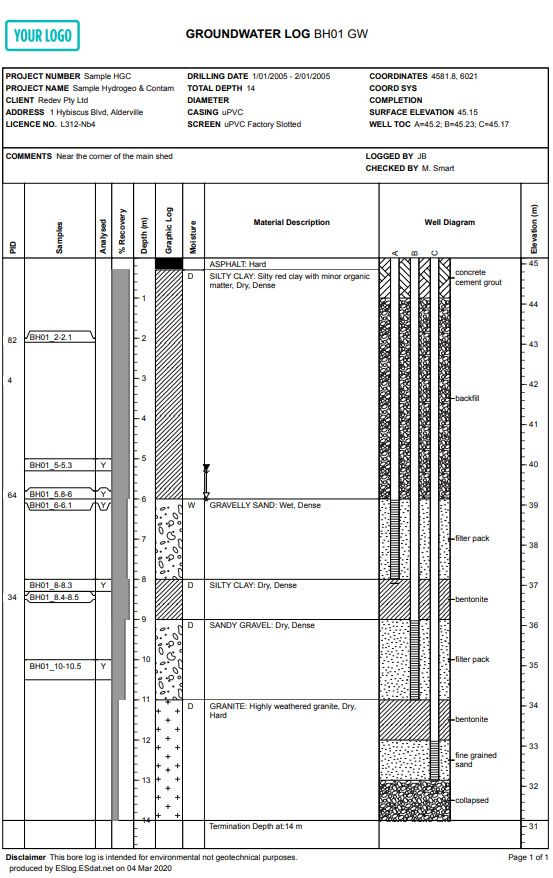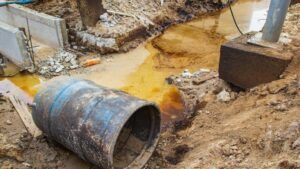A bore log is a record detailing the in-situ conditions and aspects of geotechnical exploration activities such as drilling boreholes and mining. The log information needed to create a borehole log is obtained through visual inspection of samples obtained from the geotechnical process. It is also obtained through geophysical measurements made along the borehole axis by using special logging instruments that collect and record geotechnical data. A standardized log spreadsheet is used in the documentation of the data. A good borehole log should have all sections completed with the appropriate data.
The data contained in a bore log include project details (name, number, place), type of drill rig, boring depth, drilling method used, sample recovery, soil classification, soil density, soil consistency, colour, grain size, particle shape, sedimentary structure, blow counts, layer boundaries and thickness, plasticity, topsoil thickness, mineral composition, texture, strength, weathering and altercation, water content/moisture, and photographs. The data covers both soil and rocks. The units used depend on the specific aspect being measured; for instance, boring depth can be presented in meters while grain size is in millimetres.
The information provided in the bore log is useful as it gives information on soil types, consistency of soil, and water tables. Depending on the well type, such information is applied in assessments to ascertain the desirability of formations identified during drilling. It is mainly used by geotechnical engineers, geologists, geoscientists, and other drilling specialists.

Geology, Borehole & Groundwater Data
ESdat, environmental data management software, provides a complete workflow solution for loading borehole, geology and groundwater data from the desktop or the field and analyzing and reporting borehole logs, groundwater graphs and other outputs.
Electronic Bore Logging
pLog provides tablet-based bore logging for geological professionals who want a full electronic data flow from the field to the report.
pLog operates offline and runs on Toughbooks, Samsung Galaxy, or other standard Android Tablets.
- Works in the rain
- Faster data collection
- Comprehensive Borehole, Geology, and Groundwater data
- Configurable to your preferences
- Consistent dropdown descriptions or text overwrite
- Eliminates data re-entry in the office
- Eliminates transcription errors
- Syncs data to ESdat from the field
ESdat is a single repository for storing, analyzing and reporting environmental investigation and monitoring data. ESdat validates and imports data from laboratories, data loggers, field apps and spreadsheets. Users can filter and view data using the built-in graphing, mapping, tabulation, statistical and report generation tools. Increasing efficiency and confidence in the data are cited as key benefits by organizations using ESdat.
ESdat Online delivers a highly cost-effective and efficient approach to store your ongoing monitoring environmental data, optionally with a historical data upload provided as a getting started service. ESdat Online is perfect if you want a cloud-based system that collates and reports your ongoing laboratory and field results.
ESdat Server provides the advantages of ESdat Online with the option of adding ESdat Desktop for data experts to upload their historical data, effectively interrogate the raw data being used within the database, and automatically launch and send data to other Desktop Applications such as Surfer, ArcGIS and Excel.
A variety of complementary products are also available to help with related work, such as sample planning and electronic Chain of Custody (LSPECS), offline field data collection or bore logging (pLog), and production of bore logs (ESlog), public portals and customized reporting.
References
Minnesota Pollution Control Agency (2020). Summary of Information to Include on a Boring Log. Retrieved from https://stormwater.pca.state.mn.us/index.php/Summary_of_Information_to_Include_on_a_Boring_Log
Poullain, J. (2012). Boring log preparation. https://pdhonline.com/courses/c252/FHWA_NHI_01_031_ch4.pdf






